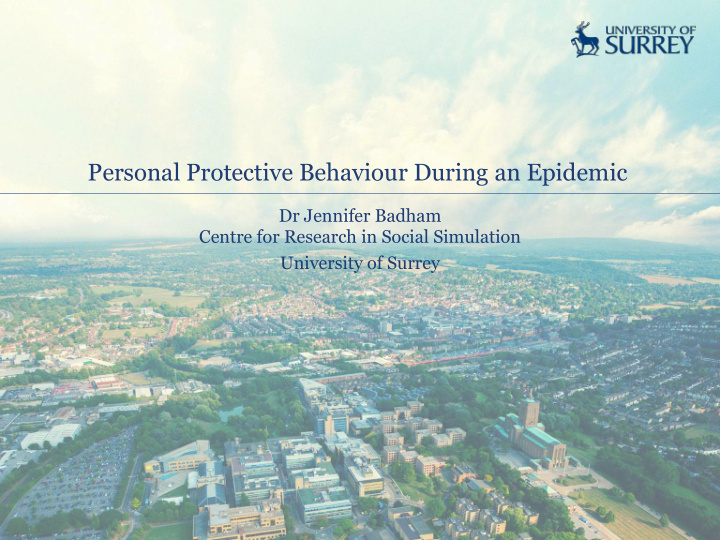



Personal Protective Behaviour During an Epidemic Dr Jennifer Badham Centre for Research in Social Simulation University of Surrey
Anticipating the panel discussion How is cognition represented in your What would you like to incorporate model? (cognition-wise) in your model ? And why haven't you? – behaviour decision based on weighted average of three – parameters that are less inputs arbitrary • attitude – minimal data for calibration • norms How would you define cognition? • threat – deliberate behaviour (contrasts with habit) Why is it important for your work to have cognitive models? – at least some ‘decision’ and potential for independence – model concerns behaviour (contrasts with norms) change – communication intended to act on cognitive decisions
What is the model for? TELL ME: European funded project about communication during an epidemic – Simulation is one of the outputs – Other partners developing communication kit Help health agencies plan communication – enter details of epidemic scenario • severity, vaccine delay, hand washing efficacy etc – try out communication strategy options • packages of messages Acknowledgement: ¡This ¡research ¡has ¡received ¡funding ¡from ¡the ¡European ¡ Research ¡Council ¡under ¡the ¡European ¡Union's ¡Seventh ¡Framework ¡Programme ¡ (FP/2007-‑2013), ¡ERC ¡Grant ¡Agreement ¡number ¡278723. ¡
Demonstration model Inputs ¡ CommunicaOon ¡ strategies ¡(media) ¡ Epidemic ¡features ¡ PopulaOon ¡density ¡ Outputs ¡ CommunicaOon ¡ effect: ¡aQtude ¡and ¡ behaviour ¡ Epidemic ¡progress ¡
Two connected models ABM for protective decisions SD (difference equations) for epidemic – heterogeneity – Standard SEIR model • location specific risk • difference equations • receive messages Focus ¡of ¡presenta.on ¡ • compartment transition – interaction Customisation • local behaviour – spatially explicit Decision based on psychological models • some travel – includes risk (from SD) – Infectivity modified by personal behaviour (from ABM)
Behaviour models Well established models from psychology about the influences on behaviour Three most relevant: – Theory of Planned Behaviour – Health Belief Model – Protection Motivation Theory
Theory of Planned Behaviour Dominant general behaviour model Linear regression – Coefficients are specific to the behaviour I. ¡Ajzen, ¡“The ¡theory ¡of ¡planned ¡behavior,” ¡ Organiza(onal ¡Behavior ¡ and ¡Human ¡Decision ¡Processes , ¡vol. ¡50, ¡no. ¡2, ¡pp. ¡179 ¡– ¡211, ¡1991 . ¡
Health Belief Model Popular for health behaviour SuscepObility ¡ MoOvaOng ¡factors ¡ No model structure Severity ¡ – identifies factors AcOon ¡ Undefined ‘cue to action’ Benefits ¡ AcOon ¡selecOon ¡ Barriers ¡ I. ¡M. ¡Rosenstock, ¡“The ¡health ¡belief ¡model ¡and ¡prevenOve ¡health ¡behavior,” ¡ Health ¡Educa(on ¡& ¡Behavior , ¡vol. ¡2, ¡no. ¡4, ¡pp. ¡354–386, ¡1974. ¡
Protection Motivation Theory Vulnerability ¡ Threat ¡ Fear motivates intent Severity ¡ But action only if belief in Fear ¡arousal ¡ efficacy – Else maladaptive Behaviour ¡ behaviour (eg denial) Efficacy ¡ Self-‑efficacy ¡ Coping ¡strategy ¡ Barriers ¡ J. ¡E. ¡Maddux ¡and ¡R. ¡W. ¡Rogers, ¡“ProtecOon ¡moOvaOon ¡and ¡self-‑efficacy: ¡A ¡revised ¡theory ¡of ¡fear ¡appeals ¡ and ¡aQtude ¡change,” ¡ Journal ¡of ¡Experimental ¡Social ¡Psychology , ¡vol. ¡19, ¡no. ¡5, ¡pp. ¡469 ¡– ¡479, ¡1983. ¡
Adopting behaviour Hybrid of TPB and HBM / PMT – factors with large effect size, dynamic Linear combination (weighted average) – attitude (score 0 to 1) – perceived norm • operationalised as proportion of visible agents who have adopted behaviour – threat • susceptibility as discounted visible cumulative incidence • severity modifier (multiplier for weight)
Broad model logic Epidemiology ¡with ¡standard ¡SEIR ¡model. ¡LocaOon ¡specific ¡ populaOon ¡informaOon ¡combines ¡with ¡infecOvity ¡to ¡ generate ¡new ¡infecOons. ¡ Individuals ¡have ¡some ¡underlying ¡willingness ¡to ¡adopt ¡ protecOve ¡behaviour ¡(eg ¡vaccinaOon, ¡hand ¡washing), ¡based ¡ on ¡demographic ¡factors ¡and ¡percepOon ¡of ¡health ¡status. ¡ Messages ¡of ¡various ¡types ¡are ¡combined ¡into ¡a ¡ communicaOon ¡strategy ¡for ¡tesOng ¡by ¡the ¡model. ¡ AQtude ¡is ¡updated ¡in ¡response ¡to ¡communicaOon ¡ Perceived ¡threat ¡or ¡risk ¡is ¡a ¡combinaOon ¡of ¡likelihood ¡ of ¡becoming ¡infected ¡and ¡the ¡consequences. ¡ Behaviour ¡arises ¡from ¡the ¡interacOon ¡of ¡aQtude, ¡social ¡ AdopOon ¡of ¡protecOve ¡behaviour ¡by ¡individuals ¡in ¡a ¡ norms ¡(nearby ¡behaviour) ¡and ¡perceived ¡threat. ¡ specific ¡locaOon ¡reduces ¡infecOvity ¡in ¡that ¡locaOon ¡ (depending ¡on ¡efficacy ¡of ¡the ¡behaviour). ¡
Calibration approach Use H1N1 (swine flu 2009) datasets to estimate 4 values for 2xbehaviour – attitude weight, norms weight, incidence discount, adoption threshold Why H1N1? – most substantial data (7 studies, up to 13 data points) – no quarantine, so ‘natural’ epidemic curve provides context – most relevant to model purposes, management plans would not rely on communication for more severe epidemics Dimension reduction – epidemic parameters from literature – simple assumptions of attitude distribution, travel rates – exclude communication
Calibration approach Parameter sweeping with some optimisation elements – working with Sandtable (UK private company) who have a specialised calibration platform 1. Generate epidemic from random seed – efficacy set to 0 so protective behaviour does not affect epidemic – locate time for epidemic peak 2. Centre behaviour data using known date of epidemic peak 3. Run model with same random seed for behaviour calibration with criteria: – mean square difference between modelled and actual behaviour – maximum proportion of population adopting behaviour – difference in dates of modelled and actual behaviour peak 4. Sensitivity analysis
Conclusions Conflict between psychologists and Consequence is modelling difficulty: social researchers about behaviour – if designed from theory, no – psychologists use formal data to calibrate structures tested by – if designed from data, no experiment theory to provide model rules • parameter values are What does this mean for project? specific to the experiment – model is prototype, links – social researchers measure communication, behaviour willingness of behaviour and epidemic outcomes • typically 5 point Likert – model does not predict, scale, not numerical represents current • measure related factors understanding of connections but without any – guide future data collection expectation of influence structure
Recommend
More recommend